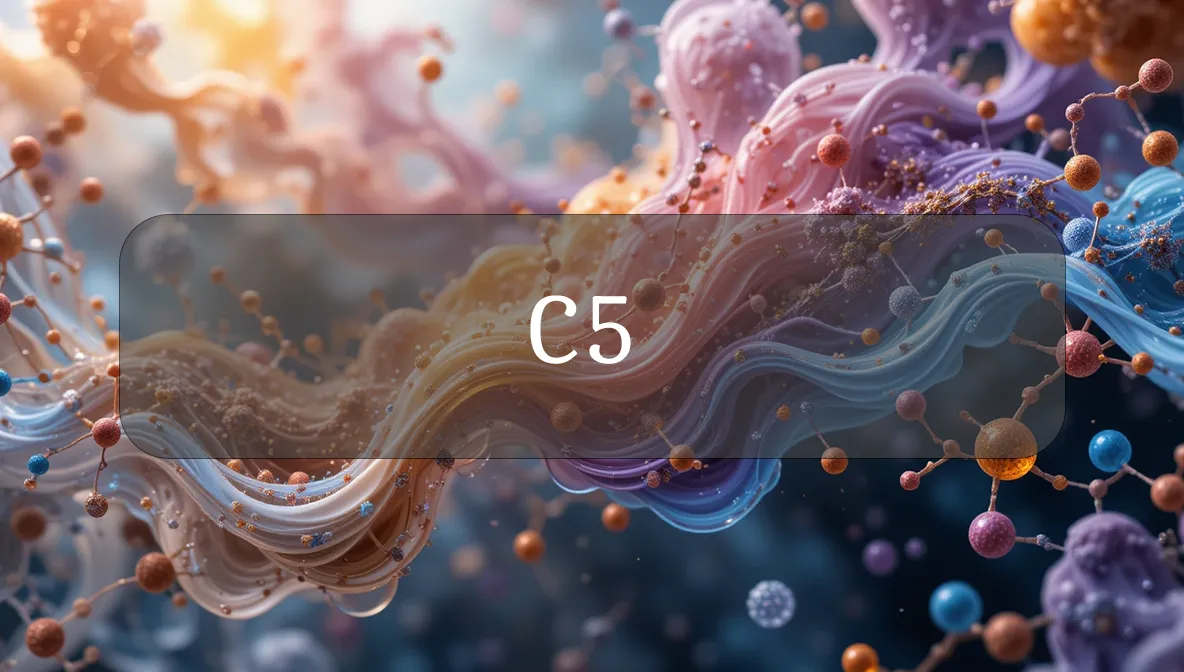Immune System’s Heavy Hitter for Defense
Complement protein C5 is like the big gun in your immune system’s complement arsenal, delivering a knockout punch to pathogens and rallying immune cells to clear infections. As a key player in the complement system, C5 amplifies your body’s defenses and ensures robust protection. For health-conscious folks eager to boost resilience, understanding C5 can unlock insights into how your body fights germs and stays balanced. Let’s dive into what C5 is, why it’s vital for your wellness, and how to support its function for a thriving you.
Identity and Function
Complement protein C5 is a large protein produced primarily in the liver and found in your blood. It’s a critical component in all three complement pathways—classical, lectin, and alternative—acting as a pivotal point in the cascade. When activated by C3 convertase (formed with help from C2, C3, or C4), C5 is cleaved into C5a and C5b. C5b initiates the formation of the membrane attack complex (MAC), which punches holes in pathogen membranes to destroy them. C5a is a potent inflammatory signal, recruiting immune cells like neutrophils to infection sites. C5 is always circulating, ready for action [1].
Immune Role and Benefits
C5 is your immune system’s powerhouse, with a significant impact on your health:
- Pathogen Destruction: C5b triggers the MAC (with C6–C9), lysing bacteria, viruses, or infected cells by creating membrane pores [2].
- Immune Recruitment: C5a draws neutrophils, macrophages, and other immune cells to infection sites, speeding up clearance and amplifying inflammation [1].
- Infection Defense: C5 is crucial against bacterial infections (e.g., Neisseria causing meningitis) and some fungi, ensuring rapid pathogen elimination [3].
- Debris Clearance: C5 helps clear immune complexes and damaged cells, preventing tissue inflammation [4].
- Health Implications: Low or dysfunctional C5 increases infection risk, especially from encapsulated bacteria like meningococcus. Overactive C5 can drive excessive inflammation in diseases like sepsis, kidney disorders, or paroxysmal nocturnal hemoglobinuria (PNH) [5].
Healthy C5 keeps your infections under control, your immune response amplified, and your body balanced.
Ways to Support Function
You don’t consume C5, but you can nurture its environment to keep it thriving:
- Balanced Diet: Proteins (e.g., fish, eggs) provide amino acids for C5 production, while vitamin C supports immune health [2].
- Hydration: Water keeps blood fluid, ensuring C5 circulates effectively [3].
- Sleep and Recovery: Adequate rest (7–8 hours nightly) supports liver function, where C5 is made [4].
- Exercise: Moderate activity (e.g., walking or yoga) boosts circulation, aiding C5 delivery to tissues [1].
Signs of Dysfunction
C5 imbalances can disrupt immune health:
- Dysfunction Signs:
- Recurrent bacterial infections, especially meningitis or gonorrhea, from low C5 activity [2].
- Chronic inflammation, swelling, or fatigue (from overactive C5 in inflammatory diseases) [3].
- Unexplained fever or slow infection recovery (linked to poor C5 function) [4].
- Causes: Genetic deficiencies (rare C5 deficiency), nutrient shortages (e.g., protein), chronic stress, or toxins like heavy metals can impair C5 function [5].
- Disease Link: C5 deficiency is linked to severe bacterial infections. Overactivity contributes to inflammatory disorders like PNH, glomerulonephritis, or acute respiratory distress syndrome [3].
If you notice frequent infections or chronic inflammation, consult a doctor, as these may signal C5-related issues.
Promoting Optimal Immune Health
You can support your C5 protein with practical, everyday habits:
- Eat Protein-Rich Foods: Aim for 0.8–1.2 g of protein per kg of body weight daily (e.g., salmon, 25 g per 3 oz; beans, 9 g per cup) to fuel C5 production in the liver [2].
- Include Immune-Boosting Nutrients: Vitamin C (e.g., bell peppers, 95 mg per cup) and zinc (e.g., pumpkin seeds, 2 mg per oz) support complement system activity [1].
- Add Antioxidants: Berries, leafy greens, or turmeric provide cell protectors to shield C5 and immune cells from stress or toxin damage [3].
- Stay Active: Engage in moderate exercise like brisk walking, cycling, or yoga (150 minutes weekly) to enhance blood flow and C5 circulation [4].
- Limit Toxins: Avoid air pollutants, smoking, or heavy metals (e.g., mercury in large fish)—use air purifiers, filtered water, and choose low-mercury fish like sardines [5].
- Stay Hydrated: Drink 8–10 cups of water daily to support blood flow, helping C5 reach tissues [2].
- Prioritize Sleep: Get 7–8 hours of rest to support liver health and C5 production, boosting immunity [3].
- Manage Stress: Practice mindfulness, deep breathing, or meditation (5–10 minutes daily) to lower cortisol, which can disrupt immune balance [4].
No specific intake exists for C5, as your body produces it, but a nutrient-rich lifestyle keeps it effective.
Safety and Stressors
C5 is safe as a natural immune component, but certain factors can stress it:
- Stressors:
- Nutrient Deficiencies: Lack of protein, vitamin C, or zinc can impair C5 production or function [3].
- Toxins: Pollutants, heavy metals (e.g., lead), or chronic alcohol can disrupt C5 activity, increasing infection risk [5].
- Chronic Stress: High stress or poor sleep can suppress liver function, reducing C5 production [4].
- Safety Considerations:
- Genetic Conditions: C5 deficiency or inflammatory diseases require medical care, not just diet [3].
- Environmental Toxins: Test well water for heavy metals and avoid polluted areas to protect C5 health [5].
- Medications: Complement inhibitors (e.g., eculizumab for PNH) target C5 activity, so follow medical guidance [2].
- Who’s at Risk? Those with poor diets, chronic stress, genetic deficiencies, or toxin exposure may face higher risks of C5 issues.
Fun Fact
C5 is like an immune wrecking ball! Its C5b fragment starts a chain that builds the MAC, drilling holes in germs like a microscopic demolition crew [1]!
Citations
- Alberts, B., et al. (2014). Molecular Biology of the Cell. Garland Science.
- National Library of Medicine. (2022). Complement System and Innate Immunity.
- Mayo Clinic. (2024). Infections and Immune Health.
- National Institute of Allergy and Infectious Diseases. (2023). Complement Deficiencies and Immunity.
- Centers for Disease Control and Prevention (CDC). (2023). Environmental Toxins and Immune Health.

